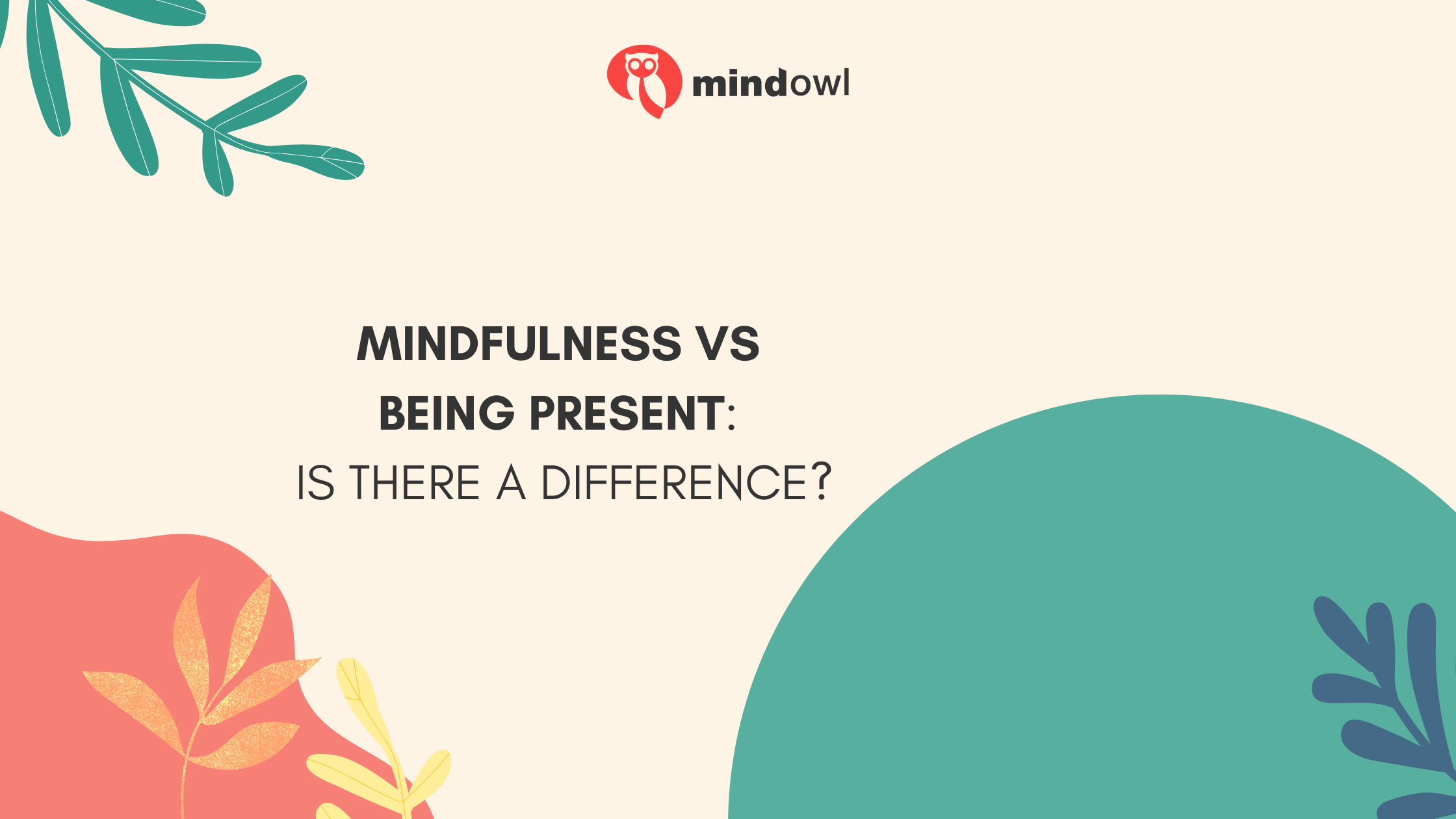
Mindfulness and being present have become buzzwords, often used interchangeably. But do they mean the same thing? Let’s crack that code together.
Mindfulness is not just about focusing on your breath or sitting quietly; it encompasses much more. It’s about enhancing your awareness and understanding of your thoughts and feelings without judgment.
This blog post will guide you through mastering mindfulness versus merely being present – yes, there is a difference! We’ll explore each concept’s focus areas, clear up any confusion, and show you how merging both into your daily life can boost well-being and productivity.
Ready for a more mindful journey? Keep reading!
Key Takeaways
- Mindfulness means paying close attention to our current thoughts, feelings, and surroundings. It helps us handle stresses better by teaching us awareness without judgment.
- Being present focuses on the here and now, letting us fully appreciate the moment we’re in. This simple act can make everyday tasks more meaningful.
- Practicing mindfulness involves activities like meditation but also extends to everyday actions like eating or walking with full awareness.
- The synergy between mindfulness and being present enhances mental well-being, enriches daily experiences, and builds emotional resilience.
- Integrating both practices into daily life through mindful breathing, gratitude exercises, and active listening can improve overall happiness and health.
Understanding Mindfulness

Mindfulness means paying close attention to what’s happening right now, without getting lost in thoughts about the past or future. It involves noticing our thoughts, feelings, bodily sensations, and everything around us with a kind heart and open mind.
We practice mindfulness through meditation where we sit quietly and focus on our breath or maybe a sound or feeling. This helps us bring our attention back to the present moment whenever our mind starts to wander.
Mindfulness is not just about knowing what you’re doing. It’s about embracing every moment with awareness.
Practicing mindfulness also includes everyday activities like eating, walking, or even washing dishes – done with full awareness of what we’re doing and sensing in that moment without distraction.
The core practices encourage us to observe life as it unfolds, staying fully engaged in each experience. Mindfulness app tools offer guided sessions to help cultivate this state of being attentive and aware at all times during daily life acts.
Impact on Mental and Emotional Well-being
Practicing mindfulness leads to stronger mental health. This happens because it teaches you how to handle your thoughts and emotions better. You learn to notice what’s happening in the moment without getting too caught up.
This skill can make you more resilient, giving you a sense of control when things get tough. Mindfulness also helps with emotional intelligence, making it easier for you to manage your feelings.
Bringing mindfulness into everyday life lowers stress and improves how your mind works. It doesn’t just stop at easing stress; it also enhances sleep, attention, self-assurance, and overall happiness.
Integrating this practice means eating mindfully or focusing on your breath during daily tasks can enrich your well-being significantly. These actions keep you grounded and promote present-moment awareness throughout the day.
Exploring the Concept of Being Present

Being present means paying full attention to the here and now. You notice what’s happening around you without letting your mind wander into the past or future. This practice is key for enjoying daily activities more fully.
It lets you live in the moment, aware of sights, smells, and sounds.
To be present is to let go of the constant chatter in our minds and focus on what truly matters—the moment itself.
This simple concept can make a big difference in how we experience life. When we stay present, we’re not just physically there; we’re mentally engaged too. We eat mindfully, listen carefully to friends, and notice small joys throughout our day.
This enhances overall happiness and helps us feel more fulfilled with what’s right in front of us.
Significance in Daily Activities
Practicing the art of being present breathes life into routine tasks, transforming them into moments of meditation in motion. This means daily activities like washing dishes or walking to work become chances to focus on the present moment.
These actions stop being mundane and start feeling more meaningful. It’s a way to embrace mindfulness without setting aside time for formal meditate sessions.
This approach can increase your overall mental and emotional well-being. Studies show that keeping your attention on what you’re doing right now helps your mind stay calm and reduces stress.
Instead of thinking about past mistakes or worrying about future problems, you notice your surroundings and take deep breaths. This simple shift in how you do everyday things enriches your physical health and keeps you grounded in here-and-now experiences.
Distinguishing Mindfulness from Being Present
Distinguishing mindfulness from being present involves understanding their focus areas and intentions. It clarifies common misconceptions and sheds light on the distinctions between the two practices.
Focus Areas and Intentions of Each Practice
Mindfulness and being present both play big roles in our mental and emotional well-being. Mindfulness meditation asks us to pay close attention to our current experiences with a curious and open mind.
This practice not only helps us notice the details of our lives but also teaches us to accept them without judgment. It’s about getting started on a journey where curiosity leads the way, allowing us to explore every sensation, thought, or feeling that arises.
On the other hand, staying in the present moment means focusing all your attention on what you’re doing right here, right now. Whether you are eating, walking, or just looking around, being present asks you to immerse fully in that activity without letting your mind wander off to past events or future worries.
This simple yet powerful act can transform everyday tasks into moments of joy and connection. By practicing being present in daily activities, we cultivate a state of mind where peace resides beyond the busy to-do list of life.
Common Misconceptions and Clarifications
Many people think that to practice the art of mindfulness, you must sit in silence for hours. This is not true. Mindfulness involves being present and engaged in whatever you’re doing, whether eating, walking, or even listening to music.
It’s about bringing your attention back to the moment without letting your mind wander off into past or future worries.
Another common belief is that mindfulness means stopping your emotions from showing up. Again, this isn’t correct. The goal is to allow all emotions – happy or sad – to surface without judgment.
This way, you learn from them and understand yourself better over time. Being mindful also doesn’t mean you’re meditating all day; it simply means integrating awareness into your daily activities to feel better overall.
The Synergy between Mindfulness and Presence
Mindfulness and presence work together to heighten awareness and attentiveness, fostering a deep connection with the present moment. Intertwining these concepts amplifies self-awareness, enriches experiences, and promotes emotional resilience.
How Each Enhances the Other
Practicing mindfulness brings your attention to the breath and helps you notice when your mind starts to wander. This skill makes it easier for you to stay in the present moment during daily tasks.
You become aware of life as it happens, from smelling a flower to feeling the sun on your skin. This awareness enriches each experience and makes being present not just an idea, but a real part of your day.
Being present boosts how well mindfulness works for you. It turns every action into a chance to practice mindfulness, whether you’re eating, walking or talking with someone. The act of fully engaging in what you’re doing without letting past or future thoughts distract you deepens your mindfulness practice over time.
As both practices feed into each other, they build a stronger mindful community around you filled with genuine connections and meaningful moments.
Practical Ways to Integrate Both in Daily Life
- Start your day with a brief mindfulness practice, focusing on your breath for a few minutes.
- Incorporate mindful moments throughout your day, such as taking a few deep breaths before starting a new task or activity.
- Practice gratitude by acknowledging and appreciating the present moment in various situations, whether at work, home, or with friends.
- Engage in active listening during conversations to fully focus on the person speaking without distractions.
- Use mindful eating by savoring each bite, appreciating the flavors and textures of your food without rushing.
- Take short breaks during the day to check in with yourself and re-center your attention on the present moment.
- Use reminders or cues in your environment to bring you back to the present when you notice your mind wandering.
- Incorporate mindful movement into your routine, such as yoga or walking meditation, to bring awareness to bodily sensations and movements.
Conclusion
In conclusion, while mindfulness and being present are closely related, they have distinct focuses and intentions. Being mindful involves a broader practice that encompasses being present but also extends to awareness in daily activities.
On the other hand, being present emphasises living fully in the current moment without distraction. By integrating both practices into daily life, individuals can experience an enhanced sense of overall well-being and engagement with the present moment.
The synergy between mindfulness and presence offers a powerful tool for cultivating mental and emotional wellness while embracing each moment with clarity and purpose. Integrating these concepts can lead to increased positive feelings and a deeper connection to one’s experiences.
FAQs
1. What’s the difference between mindfulness and being present?
Mindfulness involves practicing bringing your attention to experiences happening in the moment without judgment. Being present, however, is simply about focusing on what’s happening right now, like listening closely or enjoying a scent. Both require you to notice the here and now, but mindfulness adds a layer of awareness about your thoughts and feelings.
2. How can I get started with mindfulness?
A great way to start is by paying attention to your breath. It sounds simple, yet it’s powerful! Just sit quietly and notice how you breathe in and out – this helps bring your mind back if it starts wandering off into past or future thoughts.
3. Is there a benefit to choosing one practice over the other?
Both practices offer benefits like reducing stress and helping you enjoy life more fully. Mindfulness might give you tools for dealing with difficult emotions by noticing them without getting caught up. Meanwhile, just being present can make daily activities more enjoyable.
4. Can meditation be part of being mindful?
Absolutely! Meditation practices are a helpful way to deepen your mindfulness skills – think of them as exercises for your brain that improve focus and calmness.
5. Do I need to join a community or can I practice alone?
You may feel more supported starting out in a mindful community delivered through classes or groups because they can share tips and experiences…but really, it’s also fine doing it solo! Whether you’re sitting quietly at home or taking a mindful walk outside – what matters most is that you’re making time for yourself.
MindOwl Founder – My own struggles in life have led me to this path of understanding the human condition. I graduated with a bachelor’s degree in philosophy before completing a master’s degree in psychology at Regent’s University London. I then completed a postgraduate diploma in philosophical counselling before being trained in ACT (Acceptance and commitment therapy).
I’ve spent the last eight years studying the encounter of meditative practices with modern psychology.

